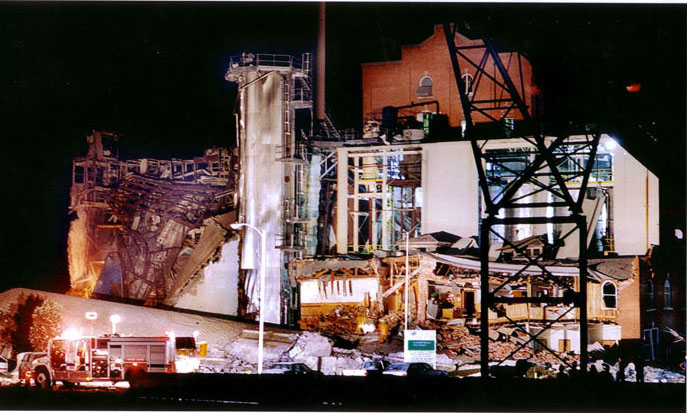Dust explosions
For 15 years, as principal specialist inspector based in HSE head office in Bootle, Alan held the topic lead on dust explosions. This covers all the industries where explosible dusts are found: wood processing, food and animal feeds, plastics and polymers, metal powders, coal and fine chemicals. In this time he was responsible for HSE technical guidance, and worked with the I Chem E on their publications. He gained from this time an unmatched knowledge of what really causes dust explosions, from decades of records of incidents investigated or reported to HSE and before that the factory inspectorate.
The Garston page on this site has a series of pictures from one of the worst dust handling plants I have ever seen.
The standard advice is that people who process explosible dusts should test the dust they use, and there are good reasons for this. However, it is not sense for every small baker to test their flour, or every woodworking shop to test their sawdust.
The best source of data on individual dusts is published by the German insurance funded organisation the IFA, who have put on line a searchable database with large numbers of entries
To access this click here
This was a sugar refinery in Nebraska. Fine sugar is a significant explosion risk, but only burns as a layer while an external flame is applied, and turns to caramel instead of smouldering.

The Nebraska picture dates from 1995, but the destructive power of dust explosions was even more vividly, and catastrophically demonstrated in Feb 2008, at the premises of Imperial Sugar, Port Wentworth, Georgia, USA. This was the second biggest sugar refinery in the USA at the time of the explosion. Out of 101 people on the premises, 14 were killed, and 38 more were injured, including 3 whose burn injuries left them in hospital 5 months later. The pictures from the Chemical Safety Board are simply shocking.The final report was issued in September 2009 Go to their website and click investigations
Compared with the major hazards petroleum and chemical industries, many powder handling industries are labour intensive, and too many scatter the potential fuel around every day, all over the premises. The results, when conditions come together to make an explosion tend to spread widely, leaving a toll of death and destruction that is greater than typical events in premises handling large amounts of flammable liquids and gases.
The biggest dust explosions with the largest loss of life have occurred in the coal mining industry. These have produced most of the biggest incidents of any type in terms of loss of life in UK industry. This page is provides more information about the causes and notable incidents